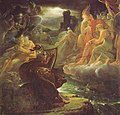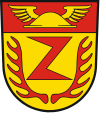Wing helmet
A winged helmet is a helmet that has wings attached to its sides .
mythology
This form of the helmet is often found in ancient and antique depictions of gods and goddesses. The Greek god Hermes (Latin Mercurius ) is regularly depicted with a winged helmet. Even Roma , the city goddess of Rome , contributes to coin a winged helmet.
Historic helmets
Helmets with decorative elements in the shape of bird or dragon wings were used in different cultures such as ancient Greece , the Roman Empire , Poland and others. In most cases it was used for ceremonial purposes. In a few exceptional cases such as the Polish balaclava or versions of the Pilos helmet , these helmets were also used in combat operations. In most cases, the winged helmets are parade designs which, due to their design, are not suitable for combat operations and so are not suitable for protecting the wearer.
19th century
Since the 19th century, winged helmets have also appeared in depictions of Germans , Gauls and Vikings . That these peoples wore winged helmets could not be proven and is doubted by science. Two reasons are named for this misrepresentation: On the one hand, the efforts of some Swedish nationalists, such as Götiska Förbundet , founded in 1811, can be proven to present the Old Norse as at least equal to the ancient culture. As a result, the Norse gods were first depicted with winged helmets, and soon more and more images of people were equipped with them. The Hermannsdenkmal Ernst von Bandels near Detmold , the construction of which lasted from 1838 to 1875, and the Vercingetorix monument in Clermont-Ferrand , which Frédéric Auguste Bartholdi created in the years 1866 to 1903, were influential here . Hermann the Cherusker also wears a winged helmet on the Hermann Heights Monument in New Ulm , Minnesota , inaugurated in 1897 . In 1899 the East Westphalian sculptor Heinrich Wefing equipped his sculpture of the Saxon Duke Widukind , which he created for a fountain in Herford , with a winged helmet.
The second root of the belief in Gallic or Germanic wing helmets can be found in the Greek writer Diodorus Siculus . In his first century BC he wrote History about the Gauls from BC:
On their heads they put bronze helmets with large knobs or large animals on them, which made the wearers of the helmets appear larger; in some cases horns are attached to it, in other cases the heads of birds and quadrupeds .
This information allows the interpretation that Gauls also attached wings to their helmets, which cannot be proven archaeologically because they were made of organic material and rotted. The Gallic helmets that were found, however, are rather round to conical and apart from a point at the apex of the helmet do not have any devices with which animal wings could have been attached to the side.
The widespread notion that the Teutons wore winged helmets also contributed to the long customary costumes in Richard Wagner's operas , in which warriors and sir wore winged helmets.
heraldry
In heraldry , the winged helmet or Mercury hat and the Mercury staff are a common figure and stand as a symbol of the Roman god Mercury for trade.
The rare heraldic figure can be in all heraldic tinctures in the coat of arms or field ; But gold is preferred. Other names such as Mercury helmet, wing hat or Hermeshut are equivalent in heraldry.
Popular culture
The trademark of the French cigarette brand Gauloises (French for "Gauls"), introduced in 1925, shows a winged helmet. Based on this, the draftsman Uderzo depicted many Gauls from his comic series Asterix with winged helmets.
They are also widespread in Anglo-American popular culture: The supernaturally fast superhero The Flash has been wearing a winged helmet since the 1940s that refers to the headgear of the Greek god Hermes. Stylized wings can also be found on the helmets of several football teams such as the Michigan Wolverines . In the fantasy novel The Lord of the Rings by the English writer JRR Tolkien , winged helmets are part of the equipment of the warriors of the fictional kingdom of Gondor .
gallery
The goddess Roma with a winged helmet on a denarius of Cn. Lucretius Trio from 136 BC. Chr.
Mercury with its typical winged helmet, painting by Hendrick Goltzius , 1611
François Gérard : Ossian invokes the gods. Painting from 1801, Malmaison Castle near Paris
The monument of Vercingetorix in Clermont-Ferrand (detail)
Detailed view of the Hermann monument near Detmold
The Germanic god Odin with a winged helmet, 1888
Brünnhilde with a winged helmet. Illustration by Arthur Rackham (1867–1939) to Richard Wagner's opera Die Walküre .
The logo of the cigarette brand Gauloises in its current form
Various characters from the Asterix comics on a Brussels mural
three Mercury hats (2; 1) in the coat of arms of Emmelshausen
Floating Mercury hat in the Belum coat of arms
Mercury hat in the shield head of Wadern (place) (valid until 1974)
Footnotes
- ↑ Wendelin Boeheim : Handbook of Armament. The weapon system in its historical development from the beginning of the Middle Ages to the end of the 18th century (= Seemanns Kunstgewerbliche Handbücher. Vol. 7, ZDB -ID 53757-3 ). Seemann, Leipzig 1890, p. 31 (ill.), 43 (ill.), 52 (ill., Text), (reprint. Fourier Verlag, Wiesbaden 1985, ISBN 3-201-00257-7 ).
- ↑ Diodorus Siculus : Bibliothéke historiké , V, 30, 2.
- ↑ also on the following see: René van Royen, Sunnyva van der Vegt: Asterix - The whole truth. CH Beck Verlag, Munich 1998, ISBN 3-406-43457-6 , p. 22f.
- ↑ René van Royen, Sunnyva van der Vegt: Asterix - The Whole Truth. CH Beck Verlag, Munich 1998, ISBN 3-406-43457-6 , p. 22.
- ↑ David Day : JRR Tolkien's Fantastic World. Moewig, Munich 1980, ISBN 3-8118-1006-5 , p. 122f.
Web links
- [1] , [2] , [3] , Wendelin Boeheim: Handbook of Arms. The weapon system in its historical development from the beginning of the Middle Ages to the end of the 18th century (= Seemanns Kunstgewerbliche Handbücher. Vol. 7, ZDB -ID 53757-3 ). Seemann, Leipzig 1890 (reprint. Fourier Verlag, Wiesbaden 1985, ISBN 3-201-00257-7 ), completely available online.
- Website Hermann Historica, Munich, Hellenistic Pilos helmet with wings
- Christie's website, London, Phrygian-Chalcidian winged helmet












